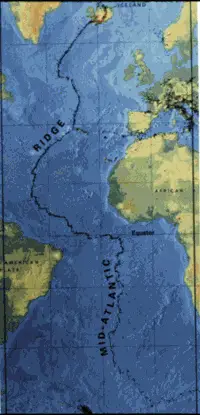Mid-Atlantic Ridge
The Mid-Atlantic Ridge is a mostly underwater mountain range of the Atlantic Ocean that runs from 87°N (about 333 km South of the North Pole) to subantarctic Bouvet Island, where it turns into Atlantic-Indian-Ridge and continues further East through Crozet Plateau to the Southwest Indian Ridge, while in the West it is followed by Scotia Ridge. It is part of the mid-oceanic ridge. The highest peaks of this mountain range extend above the water mark, to form islands. Near the Equator, the Mid-Atlantic Ridge is dissected into the North Atlantic Ridge and the South Atlantic Ridge by the Romanche Trench, a narrow submarine trench with a maximum depth of 7 758 m, one of the deepest locations of the Atlantic Ocean. The portion of the ridge north of Iceland is in fact part of the Arctic Ocean. The islands are, from North to South, with their respective highest peaks, elevations in m, and location:
Northern Hemisphere (North Atlantic Ridge):
- Jan Mayen (Beerenberg, 2277 m, at 71°06'N, 08°12'W), in the Arctic Ocean
- Iceland (Hvannadalshnúkur in the Vatnajökull, 2119 m, at 64°01'N, 16°41'W)
- Azores (Ponta do Pico or Pico Alto, on Pico Island, 2351 m, at 38°28'0"N, 28°24'0"W)
- Saint Peter and Paul Rocks (Southwest Rock, 22.5 m, at 00°55'08"N, 29°20'35"W)
Southern Hemisphere (South Atlantic Ridge):
- Ascension Island (The Peak, Green Mountain, 859 m, at 07°59'S, 14°25'W)
- Tristan da Cunha (Queen Mary's Peak, 2062 m, at 37°05'S, 12°17'W)
- Gough Island (Edinburgh Peak, 909 m, at 40°20'S, 10°00'W)
- Bouvet Island (Olavtoppen, 780 m, at 54°24'S, 03°21'E)
These mountain ranges are where tectonic plates pull apart, this pulling motion creates cracks in the ocean floor called rift zones. As the plates pull apart, magma rises to fill in the spaces. Heat from the magma causes the crust on either side of the rifts to expand, forming the ridges. The ridge was discovered by Bruce Heezen and Marie Tharp in the 1950s. The discovery of this ridge led to the theory of seafloor spreading and general acceptance of Wegener's theory of continental drift. According to plate tectonics, this ridge runs along a divergent boundary.
This ridge is an oceanic rift that separates the North American Plate from the Eurasian Plate in the North Atlantic, and the South American Plate from the African Plate in the South Atlantic. The ridge actually sits on top of the mid-Atlantic rise which is a progressive bulge that also runs the length of the Atlantic Ocean with the ridge resting on the highest point of this linear bulge. This bulge is thought to be caused by upward convective forces in the asthenosphere pushing the oceanic crust and lithosphere.
This divergent boundary first formed in the Triassic period when a series of three-armed grabens coalesced on the supercontinent Pangaea to form the Ridge. Usually only two arms of any given three-armed graben become part of a divergent plate boundary. The failed arms are called aulacogens and the aulacogens of the Mid-Atlantic Ridge eventually became many of the large river valleys seen along the Americas, and Africa (including the Mississippi River, Amazon River and Niger River).
Credits
New World Encyclopedia writers and editors rewrote and completed the Wikipedia article in accordance with New World Encyclopedia standards. This article abides by terms of the Creative Commons CC-by-sa 3.0 License (CC-by-sa), which may be used and disseminated with proper attribution. Credit is due under the terms of this license that can reference both the New World Encyclopedia contributors and the selfless volunteer contributors of the Wikimedia Foundation. To cite this article click here for a list of acceptable citing formats.The history of earlier contributions by wikipedians is accessible to researchers here:
The history of this article since it was imported to New World Encyclopedia:
Note: Some restrictions may apply to use of individual images which are separately licensed.
